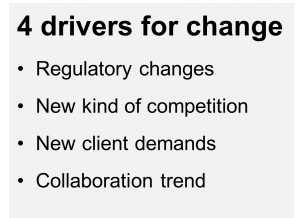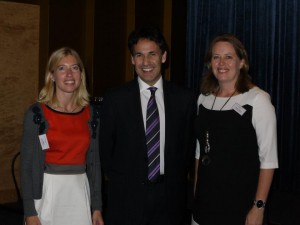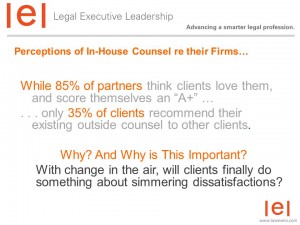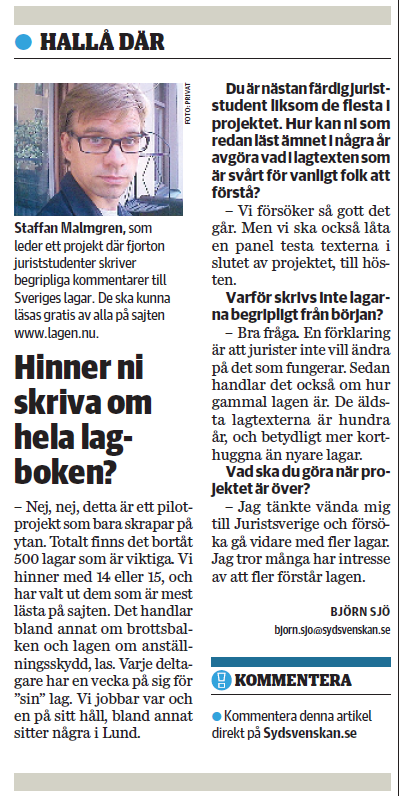The other day a friend came to me because he heard about the openlaws.eu project. He said: “Hey, openlaws sounds great – does that mean that I can write my own laws now?”. I had to tell him no, but that it was almost as good as that… Continue reading »
VoxPopuLII
openlaws
The legal profession has for long been notoriously averse to change, but now even the legal industry is affected by a new harsher reality with widespread changes impacting legal practice and client service. These changes come not merely from the aftermath of the economic downturn with price pressure and increased demands from clients, but also from the technological developments and regulatory changes that provide breeding ground for new kinds of competition. This post discusses the future of legal service, with a specific focus on how the current changes on the legal market demand a more strategic approach to knowledge management and efficient working processes and how technology is becoming more and more important as a way to develop new innovative ways to deliver legal services.
1. CHANGING LEGAL MARKET
For a long time, the legal market has been spared from some of the general business realities applicable to almost all other industries. Law has been something of a protected industry, with lawyers in a unique position as the only legitimate provider with access to legal knowledge and tools and no real competition – a “black box” exempt from normal rules of business, such as predictability in cost and time, budget restraints and value for money. After selection, the relationship with the client was controlled by the law firm, which decided almost entirely by itself how the service was to be delivered, billing it by the hour and dictating cost, pricing, staffing and strategic direction, with no need to innovate or provide cost-efficient legal services. Jordan Furlong has described this closed market more in detail and how the legal marketplace now is changing, in the series “The evolution of the legal services market stage 1-5”
But now, there are strong drivers for change affecting the legal market and rapidly forcing it out of the “black box” towards a new reality. One such driver is the regulatory changes in UK, with the Legal Services Act allowing different types of lawyer and non-lawyer to form businesses together, thereby facilitating the development of Alternative Business Structures, with external investments, in legal service providers. These regulatory changes have opened up the legal market for a new kind of competition from new entrants with disruptive business models. Unlike conventional law firms, these new providers tend to have a greater focus on rethinking legal services. They have developed both different kinds of legal services and new ways of providing them. They use technology to improve the way they connect to clients, offering new and easier ways to conduct legal tasks over the Internet, providing cloud-based customized legal documents and advice with arguments like “No surprise pricing. No hourly fees, no shocking bills.” This is a market that has gained a large interest from venture capitalists, for example by Google Venture in Rocket Lawyer (which recently also acquired competitor Law Pivot), Kleiner Perkins and Institutional Venture Partners in LegalZoom and Quotidian Ventures and others in Docracy. All this clearly indicates that there is a large market opportunity for these kinds of new legal solutions that are efficient, technology-driven and affordable to users. Other interesting new legal service or knowledge providers are VentureDocs, Docstoc and the Swedish Moretime Growth On Demand. Soon, we will probably also see global legal service providers outside the legal sphere, such as department stores or investment banks, accounting firms, insurance companies, or even Amazon.
Law firms also face a new kind of competition from Legal Process Outsourcing providers (LPOs), where legal work is exported to an outside law firm or legal support services company, often in low-wage markets overseas such as India, but also to new providers within the same country or to new brands established by the law firm itself, such as Herbert Smith’s document review centre in Belfast. The most commonly offered services are document review and legal research, but recently LPOs have started to move up the value chain by providing not only due diligence services but also the agreement drafting in M&A transactions. As reported in “LPOs Stealing Deal Work from Law Firms” alternative legal service providers are beginning to take the bread-and-butter of large law firms – handling whole mergers and acquisitions, not just the due diligence aspects of deals. Beyond cost savings, LPO has advantages like access to outside talent, 24-7 availability, and the ability to quickly scale up or cut back operations. According to the international LPO Market Study, general counsel are increasingly bypassing law firms and instructing legal process outsourcing suppliers directly. Currently worth over $1bn (£629m), the LPO market is forecast to double in size in the next two to three years.
A third major driver for change is the new client demands. Due to budget restraints, most general counsel face what Professor Richard Susskind refers to as the “more for less-challenge”, when clients have more legal issues to handle, but less in-house resources and less budget to spend on external advisers. This challenge has forced general counsel to examine alternative solutions, demand discounts and alternative fee arrangements, ask for predictability and metrics–all demands for added value and efficiency. When law firms are no longer the only providers in the legal market, clients have a diverse set of options to choose from for legal advice and they no longer accept hourly billing for inefficient work. General counsel are more closely reviewing external advisers and are very cost driven. More and more they turn to cost-effective solutions, like LPOs, or deploy the idea of “multi-sourcing” with the use of different legal service providers on different elements of a legal matter. Basically, the client has taken over the driver’s seat from law firms and is now dictating cost, pricing, staffing and strategic direction, which previously was in the law firm’s control. Together, these two factors — a decline in overall legal spending and new options for legal services — combine to reduce demand for the services of lawyers.
Susan Hackett, in her key note presentation at VQ Forum 2012, described current legal market developments, which are based on shrinking demand and increasing supply, competition from non-legal sources, and a lack of experience to guide us in this rapidly changing reality. Today, many law firms still continue to work as if they can charge whatever they want for the limited services they wish to provide, which makes it difficult to profit from the more efficient and effective service delivery demanded in this competitive marketplace, while delivering greater client value. Most law firm base the lawyer compensation on lawyer activity instead of on client results. Many law firms do not even ask for feedback but simply assume that they are doing well and don’t need to change: “While 85% of partners think clients love them, only 35% of clients recommend their existing outside counsel to other clients.”
To address this “disconnect” between the lawyers’ high perception of their value, and re-connect it to what clients actually want their lawyers to do is essential in order to improve the value of long-term client relationships. Susan Hackett also pointed to the decreased client loyalty. The 2012 Altman Weil Chief Legal Officer Survey makes it clear that clients are on the move without concern for loyalty. The study reports that 77% of the participants terminate their relationships with at least one firm last year, while only 17% give their law firms an “A” grade and 87% rate their law firms’ efficiency as “low.”
An interesting new initiative to pinpoint law firms’ inefficiency has been made by D. Casey Flaherty, who has developed a basic technology competency audit that he administers to his outside counsel to show how the lack of proficiency with the common software tools at their disposal (Word, Excel, Acrobat, etc.) result in an inordinate amount of time wasted that is still billed to clients.
The fourth major driver for change on the legal market is the collaboration trend. Today’s business conditions has completely changed with the so-called ”sharing economy” and the new generation of ”Millenials”, as defined by inter alia futurist Michael Rogers. Michael Rogers talks about the future of the legal industry as an era inspired by the Millenials; those who do not consider themselves limited to meeting people in their neighborhood but instead create relationships with people all around the world, based on interests instead of locality. In this era, new business is gained through referrals and by creating relationships through social technologies, collaboration and providing information for free. This ”freemium” trend has also been noted for legal professionals in the American Bar Association’s Legal Technology Survey Report, where 56% of the respondents use a free online source for their legal research.
Clients are becoming more and more aware of the collaboration advantage. There are more and more legal collaboration portals available, such as the Association of Corporate Counsel that provides templates and other legal documents to its members, and Legal OnRamp, a collaboration system for in-house counsel and invited outside lawyers and third party service providers. Another interesting collaboration example is Pfizer Legal Alliance, a collaboration program for Pfizer’s outside counsel, which makes them work more closely and collaboratively both with Pfizer and with each other using standardized fixed-fee billing arrangements. Richard Susskind also talks about the “collaboration strategy” for law firms, where clients can come together and share the costs of certain types of legal service, as well as collaboration projects between law firms and clients, by online closed communities for collaboration, online legal services, automated drafting and electronic legal marketplaces. Although some lawyers might find this controversial, such collaboration has already started to take place: six major banks and the law firm Allen & Overyhave created a joint online legal risk management tool.
2. NEW STRATEGIC APPROACH TO KNOWLEDGE MANAGEMENT AND EFFICIENT WORKING PROCESSES
Analysing what is happening on the legal market with the new trends with LPOs, new legal service providers, virtual law firms and the increased collaboration and knowledge sharing within legal networks, you can see that clients are becoming more and more aware of new tools and processes and will start demanding their lawyers to adapt to the new technology to become more efficient. Law firms, therefore, have to review the value of their services and the use of technology to streamline processes and take better advantage of a firm’s accumulated knowledge to ensure better service than their competitors.
For the first time in legal history, there is now a true incentive for law firms to deliver results faster, through the right combination of internal and external resources and the better use of IT as a competitive edge.
This means that law firms have to take a new strategic approach to knowledge management as a business development tool, a way of delivering the changes and innovation that will help law firms to survive and thrive in today’s dynamic and uncertain business and professional landscape.
Furthermore, clients are no longer depending upon their law firms to receive standardized legal documents, since there are several sites with online legal documents easily available, often for free, as well as collaboration portals. Law firms have lost control over the legal documents they earlier considered the “crown jewels” of the firm. It also means that demanding and skilled clients, like in-house counsels, have easy access to more affordable legal resources and are becoming less willing to pay high fees for some of the work done by junior associates.
Law firms, therefore, have to rethink their view of these legal documents and realize they are only the basis for their legal service and are already easy available for the clients. Instead, they have to look closer at how to better share knowledge from their experience, better re-use documents they have developed, standardize more routine work, and to analyse their most valuable knowledge in order to leverage it to fully support their clients.
The American Lawyers’ survey reported recently that law firms seem to have realised this need for a more strategic approach to knowledge management (KM) and that firms were pushing for greater efficiency in their internal operations. Nearly half of the 200 responding law firms said they had aligned partner compensation with a willingness to cooperate in new initiatives, such as knowledge management. Mary Abraham has discussed the impact of this report in “Guiding Partners to Better Law Firm KM” and how KM professionals best should take advantage of this windfall by avoiding the traditional precedent collection projects or model-document drafting projects and instead focus on high-impact KM activities. This means investing in the KM projects that will provide the greatest return on investment for the firm. This also means that legal knowledge management is transforming, from the previously dominating precedent and knowledge-base building, to focus on problem solving and business development. Legal KM today is something very different from legal KM in its early days. Ron Friedmann has provided his inside insights on this transition in “The Evolution of KM from Content to Tools to True Productivity”:
“In the 1990s, we talked about work product retrieval and precedents. That continued into the new century until we finally realised how hard it is to find work products and to write, maintain, and organize precedents. Moreover, we also realised that content is not enough. We broadened our focus to finding experienced lawyers and finding relevant matters. /…/ More recently, KM has shifted again. Many KM professionals today focus on legal project management, alternative pricing arrangements and process improvement. In my view, this reflects more a discontinuity or abrupt shift than evolution. Legal KM sees the light: content is not an end. Even software is only a means to an end. The real end, the real goal, perhaps the Holy Grail, is improving lawyer productivity; is solving real problem.”
Michael Koenig also points to how “legal KM has its roots in helping attorneys practice more efficiently and effectively, by drawing on colleagues’ prior work product and through sharing information, expertise, and documents within the firm. Historically, much of this sharing happened without colleagues realizing it—KM was at work behind the scenes finding and organizing resources created by individual attorneys and providing searchable, efficient access to that product to all attorneys.” But when “combining strategic development of template or master resources with document automation, KM can shift attorneys from the ancient practice of search/save as/edit to web-based questionnaires that generate a customized “best practice” final document, at a fraction of the time and cost it would take to start from scratch and without the propensity for errors inherent in editing an older document.”
What is really interesting today is that not only legal KM professionals sees this “Holy Grail of legal KM” that Ron Friedmann refers to, but also recent developments in the legal publishing world prove that legal publishers are on the same path; e.g. Rocket Lawyers acquisition of LawPivot and Thomson Reuters’ launch of client-centric platforms. Thus both legal KM professionals and legal publishers seem to agree that it is not enough to provide information, work products or precedents. Instead, focus is on supporting lawyers to improve the way they work and serve clients, and ultimately to improve how law firms operate as businesses.
In “Is KM a Real Force Multiplier?” Mary Abraham explained how KM needs to improve productivity and problem solving and how “the key to force multiplications is not to settle for incremental improvements but to aim for dramatically improved results”. With such a new focus, the Holy Grail of legal knowledge management appears to be within reach — where the goal of KM is to provide true competitive advantage by developing a combination of tools and content to improve lawyer productivity, solve real problems and make the business more profitable.
By using IT in the right way, the possibilities of finding relevant information will be substantially improved and the internal knowledge sharing will be leveraged, since previous lessons learned, best practices and new ways of solving problems can be better shared and taken advantage of by all lawyers. Through these methods, substantial efficiency improvements and increased profitability can be reached. Developments in information technology will enhance the efficiency of legal work, not only by the use of standard documents like templates and checklists, but also by proceduralized processes and automated workflows. Systematization can also extend, however, to the actual drafting of documents by the use of document assembly technology. By implementing automated document production to support standardization, firms will be able to deliver the same quality legal services and still maintain profit margins regardless of fee structure.
Richard Susskind predicts this to be the future of legal service: “These systems, which can be used within legal businesses or made available online, are disruptive for lawyers who charge for their time, because they enable documents to be generated in minutes whereas, in the past, they would have taken many hours to craft. The end result is a tailored solution, delivered by an advanced system rather than by a human craftsman. That is the future of legal service.”
3. CONCLUSION
With a new approach to knowledge management as a management issue for the whole business, with embraced technology and new approaches to standardization by using document assembly tools and buying basic documents externally, substantial improvements in efficiency and increased profitability can be reached. Law firms will prosper by finding new legal services to offer their clients. New business opportunities will arise in the provision of services to fixed prices by the use of new specialized and individualized solutions for clients.
Helena Hallgarn and Ann Björk are founders of Virtual Intelligence VQ, a Swedish consultancy firm that combines the practice of law with IT and knowledge management skills. They are two of the most experienced knowledge management professionals in Scandinavia, with backgrounds from legal practice and KM work at Scandinavian law firms Vinge, Mannheimer Swartling and Gernandt & Danielsson. Their focus is to strategically develop legal KM and drive innovation in the legal profession.
Helena and Ann blog at Legal Innovation Blog and manage the LinkedIn-discussion group Legal Innovation. Each year they also arrange VQ Forum with a focus on the most interesting ongoing discussions worldwide on strategy, leadership, innovation, technology and knowledge management for the legal sector. Helena and Ann can also be found as @VQab on Twitter.
VoxPopuLII is edited by Judith Pratt. Editors-in-Chief are Stephanie Davidson and Christine Kirchberger, to whom queries should be directed.
Context and Legal Informatics Research
[Editor’s Note: A slighly different version of this post was published on Slaw in May 2010. We thank Slaw‘s editor, Professor Simon Fodden, for granting permission to repost.]
 The relationship of legal information to context is a key dimension of recent developments in legal informatics scholarship and innovation. These developments range from investigations in law and psychology to political and moral theory, from explorations in artificial intelligence and law to legal information theory, and from research on the legal Semantic Web to the creation of new applications that help nonlawyers contextualize legal information.
The relationship of legal information to context is a key dimension of recent developments in legal informatics scholarship and innovation. These developments range from investigations in law and psychology to political and moral theory, from explorations in artificial intelligence and law to legal information theory, and from research on the legal Semantic Web to the creation of new applications that help nonlawyers contextualize legal information.
Professor Helen Nissenbaum has foregrounded the notion of context in the debate over privacy respecting court records. In her new book, Privacy in Context, and in her presentation at the 2010 Princeton Open Government Workshop, Nissenbaum defines the right to privacy as the right to what she calls “contextual integrity,” meaning the use or “flow” of information consistent with the norm for information transfer applicable in the particular context — such as home, school, workplace, court, etc. — where the information was first transferred. For Nissenbaum, key characteristics of an information context — the sender of the information, the intended recipient of the information, the subject of the information, the type of information that is shared, and the purposes and goals served by the information context — determine which norm governs information flow in that context. In Nissenbaum’s view, when information about individuals flows in a manner consistent with its contextual norm, “contextual integrity” — and those individuals’ privacy rights — are considered to have been preserved, but if that information flows in a manner inconsistent with that norm, contextual integrity — and thus the privacy rights of those individuals — are considered to have been breached. Nissenbaum argues that when a new technology — such as a publicly available online database of court records — arises that arguably violates contextual integrity, a presumption should arise in favor of preserving contextual integrity and rejecting the new technology. On Nissenbaum’s account, that presumption may be rebutted if the new technology can be shown more effectively to serve both general social values such as social welfare and national security, and also the particular purposes and goals of the original information context. Nissenbaum allows that the new technology might also prevail if it, or some aspect of the information available through it, could be modified to render it superior in vindicating both general and contextual values. Applying Nissenbaum’s model to court records would thus entail a careful consideration of a variety of contexts in which those records are generated, the rejection of certain new information technologies, and also negotiations with technologists to determine whether certain new technologies, or the data they process, could be modified so as to render those technologies superior to the original systems in vindicating general and contextual values.
Professor Guido Boella, Dr. Guido Governatori, and colleagues are exploring ways to model legal contexts to aid automated legal reasoning. In their recent paper these scholars show how defeasible logic can be employed to represent the policy context of legal rules. Their approach could improve computers’ capacity to assess legal compliance, and could contribute to the automation of the interpretation of legal language.
In legal information retrieval, K. Tamsin Maxwell — in a recent post, as well as in a recent conference paper co-authored by Burkhard Schafer — is exploring the use of Natural Language Processing techniques to contextualize queries, automate discovery of factually-similar cases, and achieve “near perfect search recall within the context of precision.”
 Recent research in law and psychology — particularly the research highlighted by The Situationist blog published by the Project on Law and Mind Sciences at Harvard Law School — emphasizes how context affects people’s understanding and use of legal information. For example, Professor Adam Benforado‘s new paper explores how spatial situations affect the law-related behavior and thinking of various participants in criminal cases, while another of his recent articles argues that the context of the videotape evidence at issue in Scott v. Harris had a profound and unacknowledged influence on the way the U.S. Supreme Court interpreted that evidence.
Recent research in law and psychology — particularly the research highlighted by The Situationist blog published by the Project on Law and Mind Sciences at Harvard Law School — emphasizes how context affects people’s understanding and use of legal information. For example, Professor Adam Benforado‘s new paper explores how spatial situations affect the law-related behavior and thinking of various participants in criminal cases, while another of his recent articles argues that the context of the videotape evidence at issue in Scott v. Harris had a profound and unacknowledged influence on the way the U.S. Supreme Court interpreted that evidence.
In her recent post and her dissertation in progress, Christine Kirchberger explores the importance of context for making legal information usable by nonlawyers. Kirchberger highlights legal Semantic Web technology — such as that discussed in Dr. Núria Casellas’s recent post on legal ontologies — and government eportals — like Austria’s HELP service — as promising means of offering valuable context to nonlawyers using legal information. Kirchberger quotes Tom Bruce‘s 2001 paper on the need to build flexible systems that can present legal information in a range of different contexts, suited to the needs of different users of those systems.
Some free access to law services are providing this kind of contextual information by building secondary sources into their systems. For example, the Cornell Legal Information Institute‘s Wex legal encyclopedia — written collaboratively by volunteers — explains key legal concepts and terms that appear in the Institute’s primary collections. As Staffan Malmgren explains in this recent post, his lagen.nu free access to law service for Sweden includes commentaries, written by means of an innovative crowdsourcing method.
Automatic linking is another method of furnishing context to users of legal information, as hotlinked citations enable quick retrieval of full text sources that make up legal context. Free access to law services such as CanLII provide such technology for linking to primary legal sources — as Ivan Mokanov explains in this recent post. In his recent thesis, conference paper, and post, Olivier Charbonneau proposes several ideas for delivering contextual information to users of free legal systems. These include personalized user interfaces; automatic display of citing sources when a cursor is placed over a passage of a primary legal document; automatic display of relevant commentaries below or alongside a primary legal text; and user ratings of user-contributed commentary, to help nonlawyers assess the quality of content.
Dr. Floris Bex in his recent dissertation and post explains how argument- and narrative-mapping technology can provide valuable context for prosecutors conducting criminal investigations. Dr. Bex describes his and his colleagues’ research — and particularly the work of Dr. Susan van den Braak — respecting a variety of applications that provide visual displays of investigators’ legal and factual arguments and narrative accounts of alleged crimes. These tools allow investigators to contextualize each relevant fact and point of law within a conceptual framework for their case.
 Two current U.S. federal court technology efforts aim to help nonlawyers put legal information in context. JERS, the Jury Evidence Recording System, enables jurors in four U.S. federal district courts to view digital representations of trial evidence and exhibits in the jury deliberation room, and navigate through the information — including via zooming and scrolling — by means of video touchscreen. This access to evidentiary information not only helps each individual juror attain a contextual understanding of the applicable law and facts of the case; it also increases the likelihood that all members of a jury will share the same understanding of the context of the case. On April 27, 2010, the Administrative Office of the U.S. Courts announced that funding for JERS had been renewed.
Two current U.S. federal court technology efforts aim to help nonlawyers put legal information in context. JERS, the Jury Evidence Recording System, enables jurors in four U.S. federal district courts to view digital representations of trial evidence and exhibits in the jury deliberation room, and navigate through the information — including via zooming and scrolling — by means of video touchscreen. This access to evidentiary information not only helps each individual juror attain a contextual understanding of the applicable law and facts of the case; it also increases the likelihood that all members of a jury will share the same understanding of the context of the case. On April 27, 2010, the Administrative Office of the U.S. Courts announced that funding for JERS had been renewed.
Whereas JERS helps jurors place legal information in context, the E Pro Se document assembly application assists self-represented litigants in contextualizing such information. A customization of the A2J Author document assembly program created for use in law school clinics by CALI, the Center for Computer Assisted Legal Instruction, and the Chicago-Kent College of Law’s Center for Access to Justice and Technology, E Pro Se conducts automated interactive interviews with pro se litigants in U.S. federal district court — for purposes of gathering contextual information from the litigants — and then processes that information to assemble pleadings and other court papers for the litigants. E Pro Se is now available online from the U.S. District Court for the Eastern District of Missouri. According to The Third Branch, the federal district court in Minnesota has begun a pilot E Pro Se project, and such a project will shortly begin in the Massachusetts federal district court. (Thanks to CALI’s Executive Director John P. Mayer for information on this topic.)
Nonlawyers who participate in policy discussions about proposed laws also need context to understand those laws. Researchers participating in the EU’s IMPACT Project are creating tools to provide this context. These tools include argument mapping applications and Semantic Web technology — described in new papers by Professor Tom van Engers and Dr. Adam Wyner — for organizing policy discussions into subject-related threads, with visual displays of the reasoning underlying the arguments that make up the discussion, translation of policy arguments into the preferred language of each user, and Web 2.0 services facilitating users’ participation in the discussions.
Context thus appears to be a focal point for legal informatics research, at the levels of theory, policy, and systems development. Research activity in this area appears to be vigorous, and embraces many disciplines in addition to law, including computer science, philosophy, political science, psychology, linguistics, sociology, anthropology, and information science. As the disintermediation of legal information professionals, the unbundling of legal services, and the participation of citizens in policy- and lawmaking proceed, the need can only grow for greater knowledge of how context affects individuals’ understanding and use of legal information, and for systems that effectively provide nonlawyers with relevant legal contextual information.
 Robert Richards, JD, MSLIS, MA, is an information and communications researcher, specializing in legal information and communication systems. He is based in Philadelphia. He is editor in chief of VoxPopuLII, writes the Legal Informatics Blog, and created and maintains the online bibliography Legal Information Systems & Legal Informatics Resources. He is the founder and administrator of the Legal Informatics Research Network, an online community for those studying or developing legal information systems. His most recent writings include What Is Legal Information?, a paper delivered at the 2009 University of Colorado at Boulder Conference on Legal Information, and Cost-Effective Research in U.S. Bankruptcy Law (2009). As of September 2010 he will be a Ph.D. student in the University of Washington Department of Communication.
Robert Richards, JD, MSLIS, MA, is an information and communications researcher, specializing in legal information and communication systems. He is based in Philadelphia. He is editor in chief of VoxPopuLII, writes the Legal Informatics Blog, and created and maintains the online bibliography Legal Information Systems & Legal Informatics Resources. He is the founder and administrator of the Legal Informatics Research Network, an online community for those studying or developing legal information systems. His most recent writings include What Is Legal Information?, a paper delivered at the 2009 University of Colorado at Boulder Conference on Legal Information, and Cost-Effective Research in U.S. Bankruptcy Law (2009). As of September 2010 he will be a Ph.D. student in the University of Washington Department of Communication.
VoxPopuLII is edited by Judith Pratt.
Crowdsourcing Legal Commentary
Background: The Need for Free Legal Commentaries
A legal commentary — also known as a legal treatise — is an unofficial text, intended to complement a particular source of law, often consisting of one or more statutes. A commentary on a statute provides information on how to interpret terms in the statutory text, summarizes examples of the statute’s application, references other relevant parts of the statutory law, and explains the legislative history and policy background of the statute. As statutory law is typically written in an open-ended way, setting forth norms in general language and usually without examples of how the law should be applied, a newcomer may have difficulty understanding it. Legal commentaries help with this.
In many jurisdictions, the texts of statutes are published by the legislature, usually without claim to copyright, and thus are made available to all, including to free-access-to-law services. Legal commentaries, by contrast, are written by private parties, who have a copyright on the resulting text, copies of which they typically sell at price levels that prevent most persons other than legal professionals from accessing them. Thus, most citizens may have free access to law, but not to the texts necessary for understanding it.
My background is that of a software developer, but in 2005 I started law school in Sweden. At that time, I couldn’t find any good freely accessible web service containing Swedish statutory law, so I built one called lagen.nu (which, translated, means “the law, now”). When the site debuted it contained around 4,000 pages of statutory law, and another 10,000 pages with headnotes on legal cases, with hyperlinks and cross-references. Over the next few years the site was gradually improved, with better hyperlinking of references, the addition of the full text of case law, and an improved graphical interface. The purpose of the site was and is to make law accessible to the common person. But making available official data such as statutory and case law can only get you so far, as there are many aspects of the law which are not apparent from the face of primary legal documents.
The Swedish legal system, like most civil law systems, is based more on statutory law than are most common law systems. Jurists in Sweden therefore spend much time interpreting statutory law. There are several publishers — including Thomson Fakta and Norstedts Juridik — that provide legal commentaries on Swedish central acts. The commentaries are written for legal professionals, which is evident in both the extent of the commentaries and their price. (As an example, the standard commentary on the Swedish code of judicial procedure fills four loose-leaf binders and costs 4435 SEK [$611 US].) As such, they are not accessible in any realistic sense to laypeople.
Therefore, I started thinking about how one could create a free commentary on Swedish law. Traditional commentaries require enormous resources, the most critical and expensive being the time of professors or other experts. Commentaries written for legal professionals generally fall into either of two categories: (1) in-depth works, or (2) practice tools. In-depth works — such as Fitger’s Rättegångsbalken — provide extensive treatment of the subject, delve deeply into the historical and teleological background of the regulation in question, and examine every conceivable exceptions-from-the-exception-to-the-rule detail. Those commentaries can be ten times the length of the actual statutory text, and are typically published in book form. In particular, they are written for readers who already understand the basic concepts and structure of the regulation, and who have time to dig deeper. For ordinary people, this level of detail is neither needed nor wanted.
In addition, there are practice tools, shorter commentaries more suited for the practicing lawyer who needs to quickly understand a particular regulation. These are still written for professionals, and are typically accessible as part of an electronic database subscription. Such subscriptions are priced far beyond the reach of non-professionals as well.
Thus neither form of commentary is written for laypeople, and neither is readily available to them. In order for the law to be accessible to all, it needs to be explained differently, and the explanation needs to be freely available. Writing this sort of commentary doesn’t require a tenured professor. In fact, the basic aspects of any central act can be adequately explained by any law student having the following two qualities:
a) A thorough understanding of the subject (for example, having taken the relevant course and having received a good grade); and
b) A talent for explaining complex things succinctly. At this, the student may even outdo the professor, as the student — having recently been a novice respecting the topic — will have a better understanding of how the subject is approached by someone new to it.
In any given act, there are a handful of key sections. A brief introduction to the act, combined with short explanations of these key sections, would be enough to create something useful to a nonlawyer. A person with a good knowledge of the act could write this in an evening. Something more extensive, like a basic commentary on the interesting parts of any central act, could be written in one or two weeks of work.
Still, there are a lot of central acts in Swedish law, and of only a few of these do I have extensive knowledge. Since I wouldn’t be able to write all the commentary myself, I’d have to create something that made it possible for people more knowledgeable than I to contribute their knowledge. Thus, the solution would have two aspects — one technological, one social. During the spring, summer, and autumn of 2009, we tried to create this solution.
extensive knowledge. Since I wouldn’t be able to write all the commentary myself, I’d have to create something that made it possible for people more knowledgeable than I to contribute their knowledge. Thus, the solution would have two aspects — one technological, one social. During the spring, summer, and autumn of 2009, we tried to create this solution.
Technology: Collaborative Writing Tools
In our proposed free online system, a commentary for a single act would normally contain a brief introduction to the act itself, followed by comments on the most important sections. A simple way to do this is to write the entire commentary as a single text document, divided into different parts, each referencing a particular section of the act. Acts in the Swedish law system can vary greatly in length, with some being only a sentence long, and some being over 100,000 words long and containing over 1000 different sections. However, the decision to use one single commentary text per act was made in order to keep things simple.
Swedish acts are typically divided into chapters, which are divided into sections (though for shorter acts, only sections are used). For example, the second section of the fourth chapter of an act is referenced as “4 kap. 2 §”. We adopted a convention of using such a reference as a header preceding the commentary for the referenced section.
Apart from headings, we tried to use as little formatting as possible. Basic bold and italics were desirable, as were different sorts of lists (ordered, unordered, and definition lists), but not things like multiple fonts or footnotes. Hyperlinks, both internal within the system and external to other web pages, were encouraged.
Apart from commentaries on the acts themselves, we wanted to be able to describe important concepts referred to in the acts. To write succinct explanations of statutes, one often has to refer to central legal concepts (such as “The rule of law“). If that reference can be linked to a page that describes the concept in greater detail, the commentary can be made shorter and the user can decide whether to follow the link if more explanation is needed. Furthermore, the concept can be referred to from multiple commentaries.
In order for the process to be as simple as possible, we needed a web-based editing system that didn’t require any particular piece of software on the user’s computer. We also didn’t want to spend significant time developing or customizing software.
The decision was made to use MediaWiki, the software behind Wikipedia, for the task. MediaWiki is a very robust and well developed piece of software with an active developer community. It’s also easy to extend with “hooks,” that is, small pieces of code that are configured to run in certain situations (such when a page is saved). Pages can be hyperlinked, and basic formatting such as headings and lists can be done using a simple markup language, normally referred to as “wikitext.”
As MediaWiki is based around the editing of pages, the commentary for each act in our system would take the form of a page, and the description for each legal concept would also constitute a page. In Swedish law, acts and ordinances are published in a collection called SFS (Svensk författningssamling). Each act or ordinance is given an identifying number: e.g., the public access to information and secrecy act is known as “SFS 2009:400”. In our free online system, this would correspond to a commentary page called SFS/2009:400.
Unlike Wikipedia, we did not want to use MediaWiki as the interface for the reader. The primary reason for this was that we wanted to present the statutory text and the commentary side-by-side. In order to do that, we needed to extract the text that we had edited using MediaWiki, split it up into commentaries for each individual section, and then weave the statutory text and the commentary text together. (Click here to see an example.)
The architecture of lagen.nu is such that no pages are ever created dynamically in response to a user’s request. Instead, everything is pre-rendered in the form of static HTML files on disc. This makes the site responsive even when running on modest hardware and under high loads. A hook was developed so that every time a wiki page in the main namespace was saved, a program to weave together that commentary text with the statutory text was run. The result was stored as a normal HTML file on disc.
Writing the program to do this weaving was not a trivial task. In particular, translating the minimalist wikitext markup into XHTML fragments proved to be difficult, and not all MediaWiki markup was supported. We also needed to do custom processing of the commentary text. Luckily, a library was found that parsed the MediaWiki markup and returned the equivalent XHTML markup. This library was extended in order to identify references to acts, sections, and legal cases present in the system. This enabled the commentary authors, who were not expected to learn advanced hyperlinking syntax, to just write normal legal prose, which was then linked automatically.
Using this setup, the editing process boiled down to these steps:
- Find the act to be commented on on the main site, and click the “edit commentary” link.
- This leads to a MediaWiki editing page — or, if the user is not logged in, to a login form.
- The user creates or edits the commentary, saving occasionally.
- When saving, the edit can be flagged as a “minor edit”. When this is the case, the weaving process is not run, enabling the user to save work that is still in progress without changing the contents of the main site.
- When the user is satisfied (which does not necessarily mean that he/she is altogether done with writing the commentary, just that it is in such a state that it can be published on the main site), the page is saved and the weaving process is run.
- The user can then check the main site and verify that the statutory text and the commentary text look OK side by side.
Social Aspects: Coordinating the Writing Effort
The plan was to get motivated law students to write the commentary for our free online system. We formed a group of 14 people, consisting mostly of law students, but including some practicing or retired lawyers. They were each given an assignment, normally consisting of a single act, and the instruction to write the best commentary on that act that they could fashion, within a 40 hour period. For some longer acts, this limit was extended to 60 or 80 hours. The authors retained copyright in their work, and were to receive attribution for it, but they agreed to license it under a Creative Commons license (specifically the CC-BY-SA license). They were also given a small monetary compensation for their work. The deadline for completing the writing assignments was set for October 1st.
At the start of summer 2009, we held an initial workshop where the motivation and impetus of the project were explained, and where people were given some hands-on instruction in how to write and edit commentary. For the rest of the summer, project members communicated using an email mailing list, together with occasional get-togethers on Saturdays at the central library in Stockholm.
During this time, the framework for writing, as well as the results, were constantly examined and improved. My roles were those of software developer (fine-tuning the weaving process), editor (suggesting improvements to individual commentaries as they were written), and project manager (gently reminding everyone of the impending October deadline).
It soon became apparent that everyone had his or her own idea of how commentaries should be written. In general, this diversity is a good thing — if everyone tries out their ideas, we can see what works and what doesn’t. However, if everyone is forced to invent their own wheels, progress is slow and resources that could be used for writing are wasted on other things.
Therefore, we wrote a style guide, containing basic guidelines with examples on how to write concisely and simply, how to refer and link to legal concepts and external resources, how to prioritize, whom to write for, and so on. A getting-started guide, and a shorter guide to MediaWiki markup, were also written.
During the writing period we were featured in the daily press, trade magazines and national radio. We were also nominated for a prize awarded by the Centre for Easy-to-Read.
Evaluation: Does It Work?
From July to September 2009, we commented on 17 acts, 1,200 individual sections, and 500 legal concepts, resulting in a total output of over 400 pages of text. A great amount of knowledge was created in an amazingly short time span. The quality assurance, which was done by me, proved to be an interesting challenge, as I’m not (as stated above) an expert on all of the acts for which commentaries were written. However, having taken basic classes on all the areas of law addressed by the commentaries, I was able to recognize most of the content of the commentaries (and to dig deeper if I found statements that seemed at odds with what I had learned). Overall, the quality of the commentaries was surprisingly high.
In conclusion, the commentary project has been a learning experience. Following the intensive activity of the summer and autumn, fewer commentaries have been added to the system. One reason for this might be that we no longer have the funds to pay authors. The monetary compensation was small but not insignificant. However, it seemed that the major incentives for authors were the opportunity to make law more accessible to others, as well as the chance to educate themselves by explaining the law to others. We have now enabled non-registered users to comment on the commentaries, using the Discussion namespace of MediaWiki. This way, we have identified and fixed many omissions and mistakes in the original commentaries.
One thing that seemed to work really well was the procedure of assigning work and following up on it. Writing a commentary on a long statute can be accomplished using free time over the course of a month or two. Setting a deadline, monitoring progress, and providing relevant feedback can serve as incentives for authors, too.
The commentaries produced by our project are written using best-efforts principles. There are no guarantees that the information in the commentaries is complete, updated, or even correct. However, having a principal author for each commentary gives that author an incentive to ensure the information in the commentary is as good as possible. Authors may use, and in fact have used, their commentaries as work samples. Even so, having someone other than the author read the text and provide feedback can improve the quality of a commentary as well.
With the commentary project, I feel we have proved that legal commentaries can be written in a crowdsourced way (even though we used monetary compensation to motivate our authors), and that wiki technology has the required capabilities, and is sufficiently user-friendly, for such an undertaking.
The next step for our commentaries project is to formalize and sustain an assignment and feedback workflow. This will require multiple project managers, and ideally some form of delegation of responsibility for different parts of the law. Further, I am confident that the project can be sustained using a voluntary framework. This remains to be proven, though.
Note: This project was supported by a grant from Internetfonden, for which we are eternally grateful.
![]()
Staffan Malmgren — the creator of the Swedish free access to law service lagen.nu — is a project manager at the Swedish Courts administration by day, working on coordinating the publishing of official legal information on the web, using structured and standardized formats (by night, he’s working on his final law school thesis, on the subject of jurisprudential relevance ranking in legal information systems).
Recent Posts
- The Balancing Act: Looking Backward, Looking Ahead
- 25 for 25: So What(‘s Next)?
- You with the law show?
- 25 for 25: City Miles, Jazz, and Beacons
- Deeply intertwingled laws
- 25 for 25: A Librarian’s Free Law Awakening
- A birthday message
- 25 for 25 – Documents to Data : A Legal Memex
- 25 for 25: Envisioning Free Access to Caselaw
- The debate on research quality criteria for legal scholarship’s assessment: some key questions










